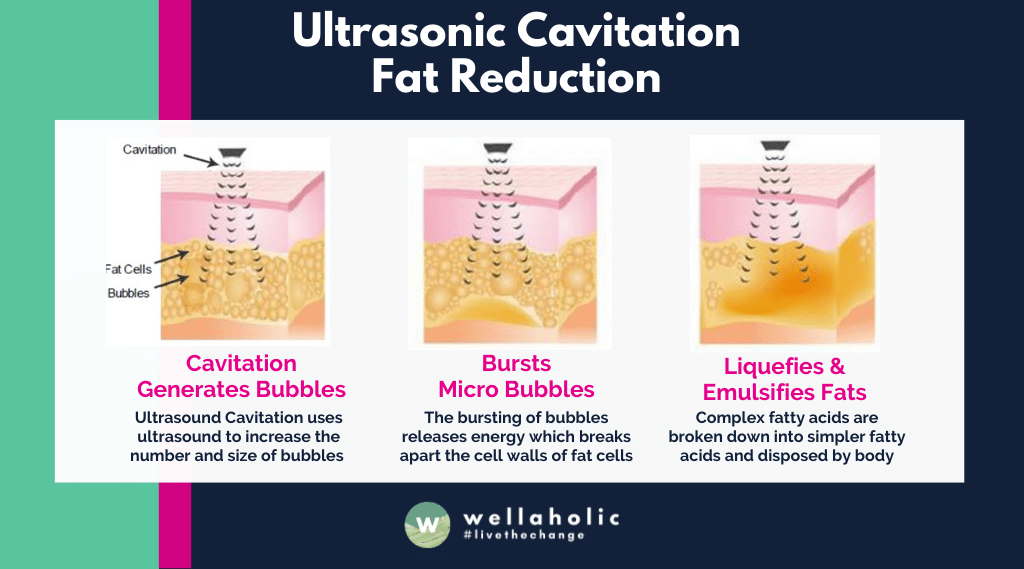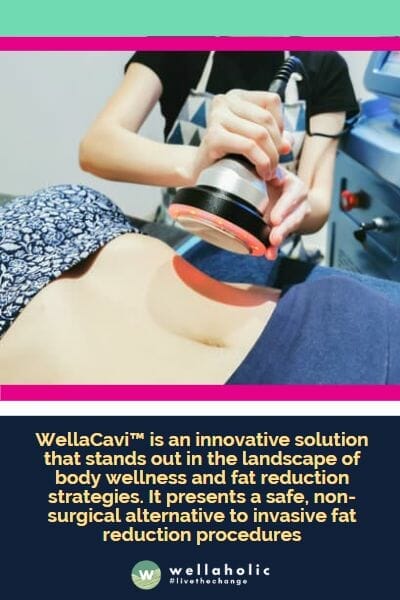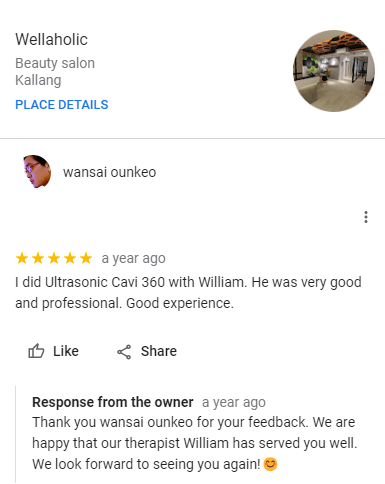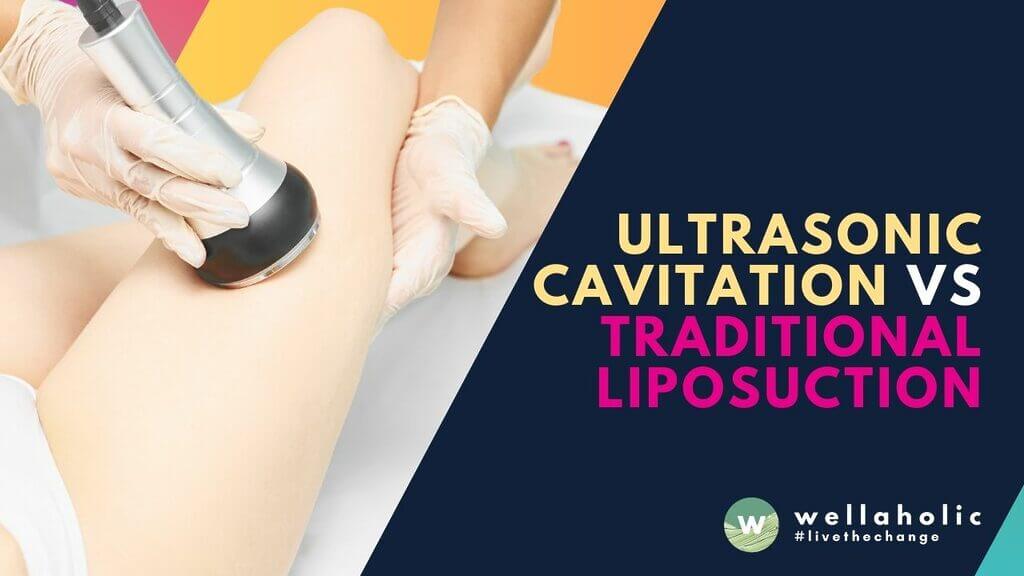
Ultrasonic Cavitation vs. Traditional Liposuction: Comparative Analysis
Ultrasonic Cavitation vs. Traditional Liposuction
Ultrasonic Cavitation
Minimally Invasive: Non-surgical, no downtime.
Recovery Time: Immediate return to activities.
Results: Gradual fat reduction over multiple sessions.
Target Areas: Suitable for small fat pockets.
Cost: Generally more affordable than surgery.
Traditional Liposuction
Invasive: Requires surgery and anesthesia.
Recovery Time: Weeks of recovery and rest needed.
Results: Immediate but can involve swelling.
Target Areas: Effective for larger fat deposits.
Cost: More expensive due to surgical fees.

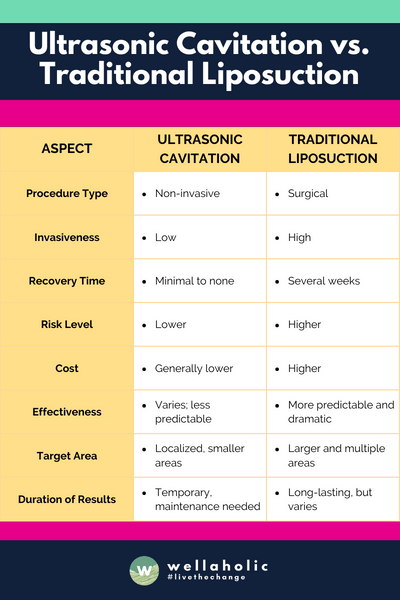
Introduction
Have you ever wondered about the differences between ultrasonic cavitation and traditional liposuction?
As aesthetic professionals with years of experience, we’ve seen many customers at Wellaholic curious about these fat reduction methods. We’ve noticed a growing interest in non-invasive treatments like ultrasonic cavitation, while traditional liposuction remains a popular choice. Through our work at Wellaholic and Laser Clinics Australia, we’ve gained insights into both procedures. We’ve observed their effects, talked to customers about their experiences, and stayed updated on the latest research.
In this article, we’ll break down the key differences between these two fat reduction techniques. We’ll cover how they work, their effectiveness, recovery time, and potential risks. Our goal is to help you understand which option might be best for your body goals.
Cavitation bubbles form and collapse more easily in liquid environments than in air. This is why fat cavitation treatments are typically performed on areas of the body with a lot of fat tissue, such as the abdomen and thighs.

How Ultrasonic Cavitation Works
As an aesthetic expert, I’ve seen ultrasonic cavitation work wonders for my customer. It’s a non-invasive way to target stubborn fat areas like love handles or thighs. The treatment uses low-frequency sound waves to break down fat cells. These waves create tiny bubbles around the fat deposits, which then burst and rupture the fat cell membranes.
Once the fat cells break down, your body naturally eliminates them through the lymphatic system. It’s like giving your body a helping hand in the fat-loss process. I often recommend this treatment to my clients who struggle with specific problem areas despite diet and exercise. It’s not a weight loss solution, but it can help contour and shape your body. Plus, there’s no downtime, so you can get back to your busy Singapore lifestyle right after a session.

Traditional Liposuction: Technique and Process
Traditional liposuction is a popular fat removal procedure I often discuss with my customers at Laser Aesthetics Australia. It uses a hollow tube called a cannula to break up and suction out fat cells. I make small incisions near the treatment area and inject a tumescent fluid. This fluid helps numb the area and make fat removal easier.
During the procedure, I move the cannula back and forth to dislodge fat deposits. It can be a bit labor-intensive, but it allows for precise sculpting. The small incisions mean minimal scarring. I’ve found this technique works well for stubborn fat pockets that don’t respond to diet and exercise. Many of my clients see great results, especially when combined with a healthy lifestyle post-treatment.
Comparing Fat Reduction Methods
In the coures of my career, I’ve seen many clients struggle with choosing between ultrasonic cavitation and liposuction. Both can be effective, but they work differently. Ultrasonic cavitation uses sound waves to break down fat cells, while liposuction physically removes fat. The best choice depends on your body and goals.
I often tell clients that ultrasonic cavitation is great for targeting small areas of stubborn fat. It’s non-invasive and has no downtime. Liposuction, on the other hand, can remove larger amounts of fat in one go. But it’s surgery, so there’s more recovery time. Your health, budget, and desired results all play a role in deciding which method is right for you. I’m always happy to discuss options and help you make the best choice for your body.
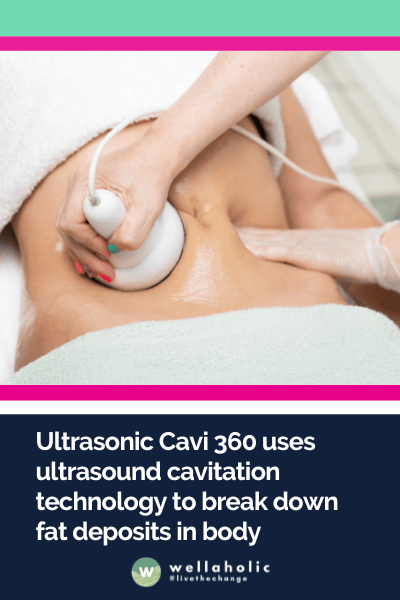
Body Sculpting and Contouring Techniques
I’ve witnessed how these techniques can transform bodies and boost confidence. From non-invasive options like CoolSculpting and radiofrequency to more comprehensive procedures like liposuction, there’s a body sculpting solution for every need and lifestyle.I recall a customer at Wellaholic, Hsieh Mei, who had been working out consistently but couldn’t seem to get rid of the fat on her lower abdomen. After a series of CoolSculpting treatments, she was thrilled with her newly sculpted midsection and felt more confident than ever.If you’re considering body sculpting, it’s important to understand your options:
- CoolSculpting: A non-invasive fat reduction treatment that freezes and eliminates fat cells.
- Radiofrequency: Uses heat to tighten skin and reduce fat.
- Liposuction: A surgical procedure that removes larger amounts of fat for more dramatic results.
No matter which technique you choose, the key is to work with a qualified professional who can help you achieve your goals safely and effectively. So if you’re ready to take your physique to the next level, consider exploring the world of body sculpting and contouring techniques.
Customer Testimonial for Benefits of Ultrasonic Cavitation
Wansai Ounkeo selected the WellaCavi Ultrasonic Cavitation treatment at Wellaholic to sculpt and contour his body. He received the treatment from William, who he found to be highly professional. Wansai observed a noticeable improvement in achieving his body contouring goals and rated his overall experience as excellent.
Read Actual Review by Customer
I did Ultrasonic Cavi 360 with William. He was very good and professional. The treatment was effective and helps with my body contouring. Good experience.(Source: Google Review)

Conclusion
My interactions with customers here at Wellaholic have consistently highlighted the importance of personal choice and circumstance in deciding between these two methods. While ultrasonic cavitation suits those who prefer a non-invasive approach and are dealing with smaller fat deposits, traditional liposuction remains a viable option for those seeking significant reshaping.
Ultimately, the decision depends on individual health, desired outcomes, and tolerance for downtime and invasiveness. As the aesthetic industry continues to evolve, understanding these nuances becomes crucial in guiding clients towards making informed decisions about their body contouring choices.
Frequently Asked Questions (FAQ)
Q: What is the difference between ultrasonic cavitation and traditional liposuction?
A: Ultrasonic cavitation and traditional liposuction are both methods used to remove fat cells from the body. Traditional liposuction is a surgical procedure that physically removes fat from the body by suction. On the other hand, ultrasonic cavitation is a non-invasive procedure, also called ultrasonic therapy, that uses ultrasonic waves to break down the fat cells, which are later naturally eliminated by the body.
Q: How does ultrasonic cavitation work as a fat reduction procedure?
A: Ultrasonic cavitation uses ultrasonic waves to break down fat cells in the body. These waves create micro bubbles that cause the fat cells to implode, converting the fat into a liquid substance that is easily removed through the body’s lymphatic and urinary system. This is why ultrasonic cavitation is often associated with weight loss and body contouring treatment.
Q: Is tumescent liposuction as effective as laser lipo in removing body fat?
A: Tumescent liposuction and laser lipo are two different types of traditional liposuction procedure. While both methods are effective in removing fat, they work differently. Laser lipo, or laser liposuction, uses a laser to liquefy the fat before it is removed, which can have a greater impact on tightening the skin in the treated area. Tumescent liposuction, however, is considered a bit more invasive and can lead to a longer recovery time.
Q: How does recovery time for ultrasonic cavitation compare to traditional liposuction?
A: Recovery from ultrasonic cavitation is usually quicker than from traditional liposuction. As a non-invasive procedure, ultrasonic cavitation won’t require bed rest or time off work and normal activities can be resumed immediately. Traditional liposuction, being a surgery, may have a longer recovery time, often requiring a few days to a week off work depending on the extent of the procedure.
Q: Can laser lipo help in weight loss?
A: While laser lipo can remove fat deposits in the body, it is not a weight loss solution. The procedure primarily aims at removing stubborn fat deposits that are resistant to diet and exercise. It is important to maintain a healthy lifestyle for long-term results.
Q: What is the best area of the body for ultrasound cavitation treatment?
A: Ultrasound cavitation can be used on most parts of the body where stubborn fat is stored. This includes the belly, love handles, back, thighs, and buttocks. The treatment is targeted to remove fat cells in these areas and help in body contouring treatment.
\

Serene Chiam, Aesthetic Director (LinkedIn)
Serene Chiam, the Aesthetic Director at Wellaholic in Singapore, is a highly accomplished professional with over a decade of experience in the aesthetics industry. Having previously served as a Clinical Aesthetics Manager with Laser Clinics Australia, Serene brings a global perspective and a deep understanding of advanced body sculpting technologies, such as WellaCavi Ultrasonic Cavitation. Her CIDESCO certificate in skincare and Bachelor of Health Science (Aesthetics) from Torrens University of Australia further solidify her expertise in providing safe, effective, and personalized treatments to help clients achieve their body goals through innovative solutions like ultrasonic cavitation.
Contact Serene at [email protected]
GET IN TOUCH
Book Now Pay Later

WellaCavi™ Ultrasonic Cavitation Fat Reduction?
- ⭐ Ultrasound Technology. WellaCavi™ Ultrasonic Cavitation fat reduction uses ultrasound cavitation technology to break down fat deposits in body.
- ⭐ Safe Treatment. WellaCavi™ Ultrasonic Cavitation is a much safer alternative to other surgical options such as liposuction.
- ⭐ Works Well on Arms, Belly, Love Handles & Thighs. WellaCavi™ Ultrasonic Cavitation works well on upper arms, belly, love handles, thighs, and back—where fat cells accumulate.
- ⭐ Complements Other Slimming Treatments. WellaCavi™ Ultrasonic Cavitation works extremely well with WellaFreeze and WellaSculpt to accelerate fat disposal via the lymphatic system.
- ⭐ Award-Winning. Wellaholic’s treatments have been recognized by top beauty publications such as Daily Vanity, Beauty Insider, and Tropika Club Magazine.
- ⭐ Over 2000 Verified Customer Reviews. Wellaholic has over 2000 positive reviews from customers, and >50% are repeat customers.
